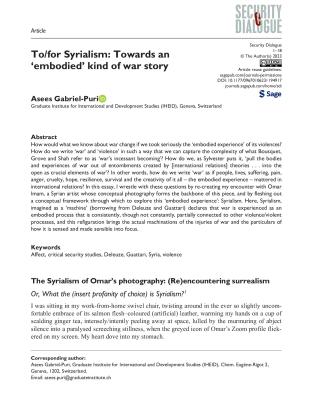How would what we know about war change if we took seriously the ‘embodied experience’ of its violences? How do we write ‘war’ and ‘violence’ in such a way that we can capture the complexity of what Bousquet, Grove and Shah refer to as ‘war’s incessant becoming’? How do we, as Sylvester puts it, ‘pull the bodies and experiences of war out of entombments created by [international relations] theories . . . into the open as crucial elements of war’? In other words, how do we write ‘war’ as if people, lives, suffering, pain, anger, cruelty, hope, resilience, survival and the creativity of it all – the embodied experience – mattered in international relations? In this essay, I wrestle with these questions by re-creating my encounter with Omar Imam, a Syrian artist whose conceptual photography forms the backbone of this piece, and by fleshing out a conceptual framework through which to explore this ‘embodied experience’: Syrialism. Here, Syrialism, imagined as a ‘machine’ (borrowing from Deleuze and Guattari) declares that war is experienced as an embodied process that is consistently, though not constantly, partially connected to other violence/violent processes, and this refiguration brings the actual machinations of the injuries of war and the particulars of how it is sensed and made sensible into focus.



